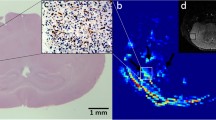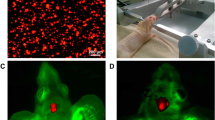Abstract
Accumulating evidence suggests that endothelial progenitor cells (EPCs) play a key role in the development and infiltration of gliomas. Thus, it has been considered that EPCs may be good vehicles for delivering anti-angiogenesis genes for tumor therapy. However, limited means of tracking these cells in vivo has restricted the effective evaluation of the curative effects of genetically modified EPCs in gliomas at different stages. The aim of this study was to develop a non-invasive method to monitor the migration of EPCs to gliomas using 1.5-T MR scanning. We successfully labeled EPCs isolated from cord blood with Resovist-PLL without any influence on the biological properties of these cells. After intravenous administration into glioma-bearing nude mice, the labeled EPCs specifically homed to gliomas and could be reliably tracked by 1.5-T MR as early as 1 day after transplantation, causing a signal loss on T2-weighted images. The dark area was detected throughout the entire tumor zone on day 5, and did not develop a ring as previously described. Histological analysis showed the labeled cells were mainly located at the periphery of the tumor where abundant neo-vessels were identified using CD34 staining; this finding indicates that the transplanted cells may be able to differentiate into ECs and become incorporated into glioma neovasculature. These results suggested that Resovist labeling of EPCs is feasible, efficient and safe for MRI tracking, and 1.5-T MR could be a powerful method for in vivo monitoring of EPCs as an anti-angiogenic drug therapy vector targets against glioma.







Similar content being viewed by others
References
Bondy ML, Scheurer ME, Malmer B, Barnholtz-Sloan JS, Davis FG, Il’yasova D, Kruchko C, McCarthy BJ, Rajaraman P, Schwartzbaum JA, Sadetzki S, Schlehofer B, Tihan T, Wiemels JL, Wrensch M, Buffler PA (2008) Brain tumor epidemiology: consensus from the Brain Tumor Epidemiology Consortium. Cancer 113:1953–1968
Folkman J (1971) Tumor angiogenesis: therapeutic implications. N Engl J Med 285:1182–1186
Carmeliet P, Jain RK (2000) Angiogenesis in cancer and other diseases. Nature 407:249–257
Lebelt A, Dzieciol J, Guzinska-Ustymowicz K, Lemancewicz D, Zimnoch L, Czykier E (2008) Angiogenesis in gliomas. Folia Histochem Cytobiol 46:69–72
Folkins C, Shaked Y, Man S, Tang T, Lee CR, Zhu Z, Hoffman RM, Kerbel RS (2009) Glioma tumor stem-like cells promote tumor angiogenesis and vasculogenesis via vascular endothelial growth factor and stromal-derived factor 1. Cancer Res 69:7243–7251
Nolan DJ, Ciarrocchi A, Mellick AS, Jaggi JS, Bambino K, Gupta S, Heikamp E, McDevitt MR, Scheinberg DA, Benezra R, Mittal V (2007) Bone marrow-derived endothelial progenitor cells are a major determinant of nascent tumor neovascularization. Genes Dev 21:1546–1558
Peters BA, Diaz LA, Polyak K, Meszler L, Romans K, Guinan EC, Antin JH, Myerson D, Hamilton SR, Vogelstein B, Kinzler KW, Lengauer C (2005) Contribution of bone marrow-derived endothelial cells to human tumor vasculature. Nat Med 11:261–262
Wong ML, Prawira A, Kaye AH, Hovens CM (2009) Tumour angiogenesis: its mechanism and therapeutic implications in malignant gliomas. J Clin Neurosci 16:1119–1130
Zhang JX, Kang CS, Shi L, Zhao P, Liu N, You YP (2010) Use of thymidine kinase gene-modified endothelial progenitor cells as a vector targeting angiogenesis in glioma gene therapy. Oncology 78:94–102
Ferrari N, Glod J, Lee J, Kobiler D, Fine HA (2003) Bone marrow-derived, endothelial progenitor-like cells as angiogenesis-selective gene-targeting vectors. Gene Ther 10:647–656
Bulte JWM (2005) Magnetic nanoparticles as markers for cellular MR imaging. Magn Magn Mater 289:423–427
Islam T, Josephson L (2009) Current state and future applications of active targeting in malignancies using superparamagnetic iron oxide nanoparticles. Cancer Biomark 5:99–107
Daldrup-Link HE, Rudelius M, Piontek G, Metz S, Brauer R, Debus G, Corot C, Schlegel J, Link TM, Peschel C, Rummeny EJ, Oostendorp RA (2005) Migration of iron oxide-labeled human hematopoietic progenitor cells in a mouse model: in vivo monitoring with 1.5-T MR imaging equipment. Radiology 234:197–205
Hinds KA, Hill JM, Shapiro EM, Laukkanen MO, Silva AC, Combs CA, Varney TR, Balaban RS, Koretsky AP, Dunbar CE (2003) Highly efficient endosomal labeling of progenitor and stem cells with large magnetic particles allows magnetic resonance imaging of single cells. Blood 102:867–872
Arbab AS, Pandit SD, Anderson SA, Yocum GT, Bur M, Frenkel V, Khuu HM, Read EJ, Frank JA (2006) Magnetic resonance imaging and confocal microscopy studies of magnetically labeled endothelial progenitor cells trafficking to sites of tumor angiogenesis. Stem Cells 24:671–678
Gao D, Nolan DJ, Mellick AS, Bambino K, McDonnell K, Mittal V (2008) Endothelial progenitor cells control the angiogenic switch in mouse lung metastasis. Science 319:195–198
Argyriou AA, Giannopoulou E, Kalofonos HP (2009) Angiogenesis and anti-angiogenic molecularly targeted therapies in malignant gliomas. Oncology 77:1–11
Zhang HR, Chen FL, Xu CP, Ping YF, Wang QL, Liang ZQ, Wang JM, Bian XW (2009) Incorporation of endothelial progenitor cells into the neovasculature of malignant glioma xenograft. J Neurooncol 93:165–174
Yoder MC, Ingram DA (2009) The definition of EPCs and other bone marrow cells contributing to neoangiogenesis and tumor growth: is there common ground for understanding the roles of numerous marrow-derived cells in the neoangiogenic process? Biochim Biophys Acta 1796:50–54
Gao D, Nolan D, McDonnell K, Vahdat L, Benezra R, Altorki N, Mittal V (2009) Bone marrow-derived endothelial progenitor cells contribute to the angiogenic switch in tumor growth and metastatic progression. Biochim Biophys Acta 1796:33–40
Zelivyanskaya ML, Nelson JA, Poluektova L, Uberti M, Mellon M, Gendelman HE, Boska MD (2003) Tracking superparamagnetic iron oxide labeled monocytes in brain by high-field magnetic resonance imaging. J Neurosci Res 73:284–295
Frank JA, Miller BR, Arbab AS, Zywicke HA, Jordan EK, Lewis BK, Bryant LH Jr, Bulte JW (2003) Clinically applicable labeling of mammalian and stem cells by combining superparamagnetic iron oxides and transfection agents. Radiology 228:480–487
Foster-Gareau P, Heyn C, Alejski A, Rutt BK (2003) Imaging single mammalian cells with a 1.5 T clinical MRI scanner. Magn Reson Med 49:968–971
Heyn C, Ronald JA, Mackenzie LT, MacDonald IC, Chambers AF, Rutt BK, Foster PJ (2006) In vivo magnetic resonance imaging of single cells in mouse brain with optical validation. Magn Reson Med 55:23–29
Arbab AS, Yocum GT, Wilson LB, Parwana A, Jordan EK, Kalish H, Frank JA (2004) Comparison of transfection agents in forming complexes with ferumoxides, cell labeling efficiency, and cellular viability. Mol Imaging 3:24–32
Farrell E, Wielopolski P, Pavljasevic P, van Tiel S, Jahr H, Verhaar J, Weinans H, Krestin G, O’brien FJ, van Osch G, Bernsen M (2008) Effects of iron oxide incorporation for long term cell tracking on MSC differentiation in vitro and in vivo. Biochem Biophys Res Commun 369:1076–1081
Kostura L, Kraitchman DL, Mackay AM, Pittenger MF, Bulte JW (2004) Feridex labeling of mesenchymal stem cells inhibits chondrogenesis but not adipogenesis or osteogenesis. NMR Biomed 17:513–517
Morreale VM, Herman BH, Der-Minassian V, Palkovits M, Klubes P, Perry D, Csiffary A, Lee AP (1993) A brain-tumor model utilizing stereotactic implantation of a permanent cannula. J Neurosurg 78:959–965
Anderson SA, Glod J, Arbab AS, Noel M, Ashari P, Fine HA, Frank JA (2005) Noninvasive MR imaging of magnetically labeled stem cells to directly identify neovasculature in a glioma model. Blood 105:420–425
Tuettenberg J, Friedel C, Vajkoczy P (2006) Angiogenesis in malignant glioma—a target for antitumor therapy? Crit Rev Oncol Hematol 59:181–193
Conti CJ (2002) Vascular endothelial growth factor: regulation in the mouse skin carcinogenesis model and use in antiangiogenesis cancer therapy. Oncologist 7:4–11
Webb CP, Vande Woude GF (2000) Genes that regulate metastasis and angiogenesis. J Neurooncol 50:71–87
Acknowledgements
We thank Mrs. Wei Sun and Miss Li-Ting Wang (Central Laboratory, Third Military Medical University, Chongqing, China) for their technical assistance in laser confocal scanning microscopy. We thank Dr. Wangxia Wang from University of Kentucky, USA, for editing this paper. This study was supported by the Foundation for Science & Technology Research Projects of Chongqing, China (NO. CSTC2007AC5014) and the Foundation of the Scientific Research of Third Military Medical University, China (2009XLC29).
Competing interests
The authors declare that they have no competing interests.
Author information
Authors and Affiliations
Corresponding authors
Rights and permissions
About this article
Cite this article
Wang, S., Fang, J., Zhang, T. et al. Magnetic resonance imaging targeting of intracranial glioma xenografts by Resovist-labeled endothelial progenitor cells. J Neurooncol 105, 67–75 (2011). https://doi.org/10.1007/s11060-011-0569-6
Received:
Accepted:
Published:
Issue Date:
DOI: https://doi.org/10.1007/s11060-011-0569-6




